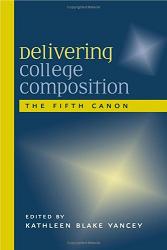
Kathleen Blake Yancey, editor (2006). Delivering College Composition: The Fifth Canon. Portsmouth, NH: Boynton/Cook. 213 pages. Reviewed by Erin Dietel-McLaughlin |
|
| Overview | |
|
While program design, classroom pedagogy, and rhetorical theory remain important areas of inquiry for compositionists, not since 1980’s “Eight Approaches to Teaching Composition” has a collection endeavored to illustrate how composition is actually being delivered to college students across the country. Kathleen Blake Yancey’s Delivering College Composition: The Fifth Canon marks a successful return to this important conversation. By exploring composition instruction in terms of delivery (itself an oft-overlooked rhetorical canon), the collection illuminates the various ways that composition spaces, faculty, and technologies have shaped contemporary approaches to college composition. The volume draws together the perspectives of more than a dozen contributors whose stories highlight how the site of composition – be it a research university, community college, liberal arts institution, or cyberclassroom – has significant bearing on the ways that instruction is delivered to students. As such, this collection should be relevant to those interested in composition pedagogy and writing program administration, while also offering useful insights for those specializing in computer-mediated composition. |
|
| Summary | |
|
The volume opens by defining some key terms: delivery (site, agent, and technology); college (the site of instruction); and composition, whose definition, as Yancey’s discussion illustrates, remains contested. In the course of this introductory chapter, Yancey points out how various factors – including technology – have led compositionists to reconceptualize what counts as “composition,” as well as what counts as a site of college instruction. Yancey then offers a brief overview of the field’s evolution over the past century, highlighting how computer-mediated instruction changed the writing process(es) and product(s), thereby challenging those in the field to redefine what counts as writing. The opening chapter concludes by articulating several driving questions, including: What is college composition? What does it look like, given the multiple ways it is delivered? Is there a common understanding about their purposes, methods, and outcomes? How do multiple delivery systems alter and redefine this thing we call college composition? How does delivery matter? These and other questions form the basis of inquiry for the thirteen articles that follow, most of which provide excellent insight into the various institutional constraints that often determine how composition is delivered. Several selections also offer commentary that is of particular interest to professionals in computers and composition: Paul Bodmer’s “Is it Pedagogical or Administrative?: Administering Distance Delivery to High Schools” discusses problems that arose when his institution began offering courses to area high schools by way of interactive television. Marvin Diogenes and Andrea A. Lunsford’s “Toward Delivering New Definitions of Writing” argues for expanded definitions of writing and “secondary literacy” before offering a case study of Stanford’s restructured first-year writing courses. Richard Courage’s “Asynchronicity: Delivering Composition and Literature in the Cyberclassroom” recounts trials and tribulations of the author’s first experience teaching a fully online composition course in the wake of 9/11. Rebecca Rickly’s “Distributed Teaching, Distributed Learning: Integrating Technology and Criteria-Driven Assessment into the Delivery of First-Year Composition” describes how WPAs at Texas Tech used a Web-based writing application to respond to issues of labor and instructional quality in the first-year writing program. Finally, in the concluding chapter, Yancey points out how composition programs used to be similar at least in the medium of delivery (print), whereas today’s multimedia and multimodal approaches to composition have remediated both the products and practices of composition. The composition we teach today, Yancey argues, is very different from the composition we taught a generation ago, as physical space, content, institutional structure, and technological innovations continue to shape the ways we deliver composition. |
|
| Critique | |
|
Packaged together, these articles provide a valuable glimpse into the various ways composition is being delivered at the college level. While the localized perspectives provide fertile ground from which to theorize, some readers may still be disappointed that there is not more of an overt attempt to theorize the canon of delivery as it relates to the field of composition studies. Also, while many parts of the discussion addressed some ramifications of treating composition as a product to be delivered only through a top-down model of instruction, the collection fails to offer a clear picture of how students perceive composition in relation to how it is delivered. In fact, an illustration of how students themselves might be considered agents of delivery would greatly enhance the volume; as it is, administrators and instructors seem to be the only agents considered. Of course, such an undertaking would likely extend the scope of delivery far beyond what would be possible for a single volume. And, these criticisms aside, Yancey’s collection lays excellent groundwork for future inquiry into delivery as theory and practice. While technology’s role in changing the landscape of composition instruction is considered throughout the text, computers and composition scholars may still yearn for more discussion of computer-mediated modes of delivery. However, Yancey’s tertiary nods to technology are appropriate and will undoubtedly prompt scholars to take up more research into this exciting area. |
|
| Conclusion | |
|
Delivery is perhaps the most overlooked and undertheorized of the five rhetorical canons, and this volume does an excellent job of opening the conversation as to how we might begin to conceptualize delivery in relation to composition studies. While it is not exclusively dedicated to exploring the role that technology plays in this delivery, Delivering College Composition provides an important first step into considering how the sites, agents, and technologies of composition continue to redefine our field. |
|